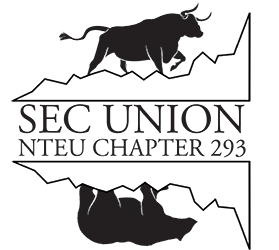H1N1 Influenza Virus
9/18/09: On September 15, 2009, NTEU participated in a conference with OPM Director John Berry, the Centers for Disease Control, the Department of Labor, and various White House officials. The conference highlighted some of the developing policies that will guide federal agencies when dealing with outbreaks of the H1N1 virus.
Dr. James Lawler, the Director for Medical Preparedness Policy on the White House’s National Security Staff, confirmed that federal health officials have been closely monitoring the H1N1 virus. Officials focused on H1N1’s behavior in the U.S. during the recent spring and summer months ― particularly in the American southeast ― as well as the disease’s behavior throughout South America during the southern hemisphere’s flu season. The belief that H1N1 could reach pandemic levels is not as pervasive as once thought. Dr. Lawler indicated that the virus’s behavior does not mirror that of the 1918 and 1957 flu epidemics, something that officials had previously feared. He warned, however, that because of H1N1’s erratic propagation pattern, what is now a favorable outlook could change in as little as a month.
Dr. Lawler explained that the disease is affecting young adults and children at a much higher rate than the elderly. This contrasts with seasonal influenza, which typically hits the elderly population ― those over 65 years of age ― hardest. While the elderly have not been as likely to contract H1N1, when they do in fact become infected they are more likely to experience harsher symptoms. In spite of the above, Dr. Lawler explained that the working age population is still at risk of contracting H1N1.
Thomas Galassi, the Director of Technical Support and Emergency Management, related his view that federal agencies should integrate pandemic planning into their existing safety and health systems. This integration would include management leadership and employee participation; hazard identification and assessment; hazard prevention and control; education and training; and system evaluation and improvement.
NTEU asked OPM whether it will support allowing employees to wear self-protective masks or other personal protective devices as individual employees deem appropriate. OPM indicated a willingness to support such behavior, but iterated that agencies will independently develop policies to deal with this issue and that, ultimately, each federal agency will be left to develop their own policies and procedures to deal with any H1N1 outbreak or threat of outbreak.
John Berry, the Director of OPM, stressed his belief that federal agencies would do well to expand telework opportunities for employees, focusing on “common sense” management practices when dealing with leave issues or employee protections. Dr. Lawler also agreed with OPM Director Berry by stating his belief that federal agencies should demonstrate common sense in, for example, not requiring employees to present doctor’s notes if they, or their family members, become infected with the H1N1 virus or even if they believe they are symptomatic.
CDC recommends that employees and employers take the following steps:
• Employees wait 24 hours after a fever has subsided before coming back to work;
• Plan for and use basic hygiene precautions like frequent hand washing, cough etiquette, and keeping surfaces clean;
• Plan for and use social distancing precautions like telework, staggered work schedules, eliminate unnecessary socializing, and communicating via e-mail or phone to reduce close contact between workers and others;
• Reduce the number of other people entering the workplace and the frequency or time that workers need to have close contact with them; and
• Provide and use personal protective equipment like face shields and facemasks.
NTEU will continue to monitor the situation closely. We are working with individual agencies on issues specific to the agencies, and will provide additional agency information as it develops. At the SEC, Chapter 293 leaders will be discussing these issues with management in the next week.
